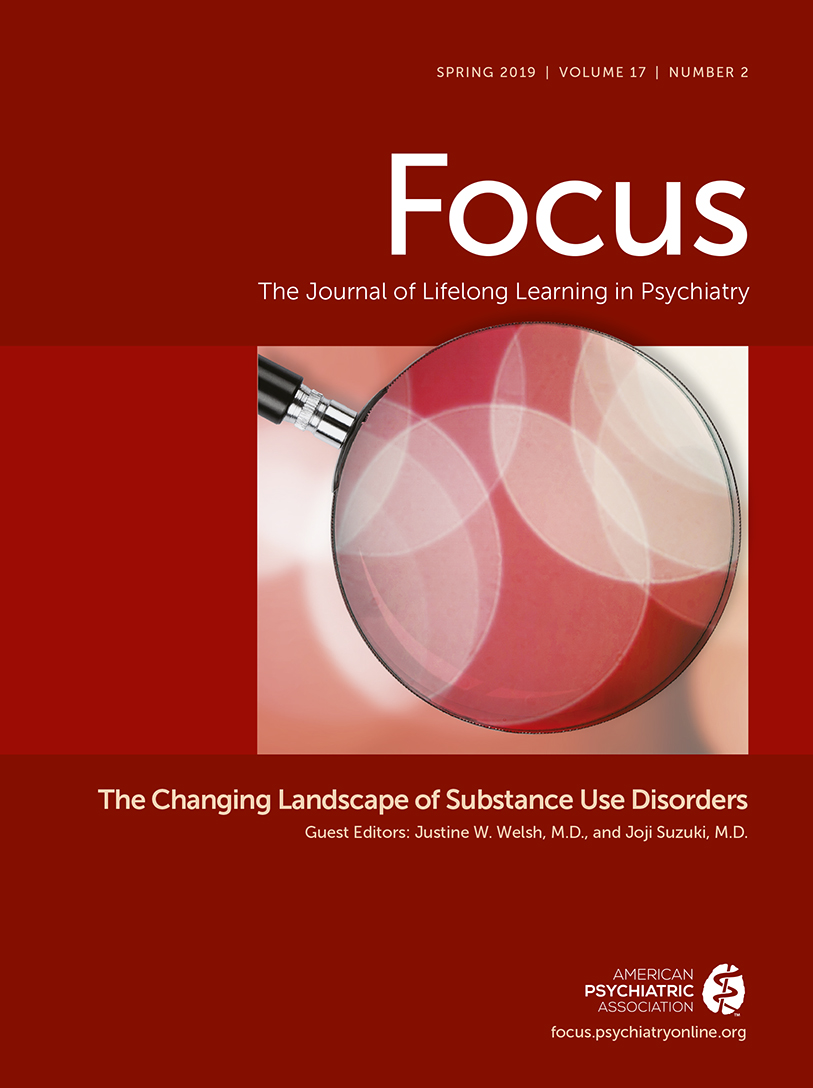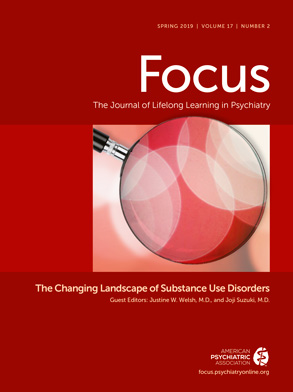According to a 2017 report published by the Substance Abuse and Mental Health Services Administration, there were 4.9 million new users of alcohol, three million new users of marijuana, two million new misusers of prescription pain medications, and 1.9 million new users of cigarettes among persons ages 12 and over (
1). Moreover, in 2017 19.7 million Americans ages 12 and over had a diagnosable substance use disorder—14.5 million with an alcohol use disorder and 7.5 million with a disorder involving an illicit drug (
1). This figure represents 6.0% of all individuals ages 12 and over in the United States.
Given that the base rate of prevalence of substance use disorders is 6% and that individuals with a substance use disorder account for nearly 20% of all those with a mental illness, clearly, substance use disorders are overrepresented among individuals with a mental illness. For clinicians this presents a formidable challenge because their patients’ underlying psychiatric disorders may worsen a comorbid substance use disorder, and similarly, a substance use disorder may exacerbate an existing psychiatric disorder. Therefore, clinicians need to be aware of the impact that these conditions have on one another and how co-occurring mental and substance use disorders affect the treatment and prognostic outcomes of their patients. For the purposes of this review, we focus on the comorbidity of and therapeutic recommendations for substance use disorder in relation to major depressive disorder, anxiety disorders, and attention-deficit hyperactivity disorder (ADHD).
Future Directions
Several pharmacological and nonpharmacological interventions have been designed to treat substance use disorder with co-occurring mental illness. A critical goal is to identify specific therapeutic options that are beneficial for individuals with co-occurring disorders. However, circumstances in both the mental health and the addiction treatment systems make the delivery of optimal health care difficult. A very promising line of research has focused on developing novel treatment approaches for co-occurring disorders.
A double-blind placebo trial by Pettinati et al. (
111) that involved patients with depression and co-occurring alcohol use disorders showed that combining sertraline and naltrexone was useful in increasing days abstinent and improving depressive symptoms, compared with treatment with sertraline alone, naltrexone alone, or placebo.
Topiramate, a nonbenzodiazepine anticonvulsant, was studied as a new therapeutic treatment for alcohol use disorder and for other substance use disorders. RCTs (
112–
114) and a meta-analysis study (
115) found topiramate to be associated with a decrease in alcohol dependence, a decline in heavy drinking days, improved quality of life, and reduction in harmful consequences of drinking, compared with placebo. To our knowledge, no study has evaluated topiramate for persons with an alcohol use disorder and a mood disorder. However, limited trials have demonstrated topiramate’s efficacy in targeting PTSD symptoms among heavy alcohol users. Alderman et al. (
116), in an open-label pilot study involving 29 combat veterans, demonstrated topiramate to be a safe and effective treatment in reducing PTSD symptoms (nightmares and anxiety) and decreasing alcohol consumption. In a prospective randomized study conducted with veterans who had co-occurring alcohol use disorder and PTSD, topiramate showed a reduction in alcohol use, cravings, and PTSD symptoms from baseline to week 12 (
117). These two studies showed topiramate to be a promising treatment for PTSD comorbid with alcohol use disorder on the basis of its GABA/glutamate inhibitory action, which is common in both disorders.
Ketamine, a dissociative anesthetic, is a potent
N-methyl-
d-aspartate (NMDA) glutaminergic receptor antagonist that may provide a novel and integrated treatment for substance use disorder with co-occurring mental illness. Meta-analyses have shown ketamine’s utility in treating severe depression and suicidal ideation (
118–
120). This is mainly the result of its effects on glutamate neuromodulation, increased prefrontal synaptic remodeling, and neural plasticity (
121–
123). This unique effect of ketamine on glutamate regulation has also shown promising results in reduced cravings, decreased self-administration of illicit drugs, and higher rates of abstinence, compared with placebo, for a variety of substance use disorders (
124–
127). However, the relevance of ketamine in a combined approach for treating comorbid depression and substance use disorder has not been fully explored in clinical trials. Many individuals have co-occurring major depressive disorder and a substance use disorder, and thus ketamine’s role as a glutamate modulator and NMDA antagonist in the brain may serve as a therapeutic target for this group.
Noninvasive brain stimulation (NIBS) technologies are becoming increasingly recognized in substance use disorder treatment for their safety, tolerability, and accessibility in modulating neural activity within the brain. Repetitive transcranial magnetic stimulation (rTMS) is an emerging NIBS intervention for treatment of substance use disorders. rTMS applies powerful and focused magnetic field pulses through the skull into the brain, leading to alterations in brain activity (
128,
129). Multiple RCTs have shown rTMS to be useful in treating major depressive disorder through enhancement of activity in the dorsolateral prefrontal cortex (DLPFC) of the brain (
130–
133). Similarly, in treating substance use disorders, rTMS has shown a reduction in craving with a small to medium effect size (
134–
146). However, its role in treating comorbid major depressive disorder and substance use disorder as a combined approach is limited. In a recent open-label follow-up study, Rapinesi et al. (
147) showed that use of high-frequency rTMS applied to bilateral DLPFC through a deep helmet coil yielded a faster response in improving depressive symptoms among patients with co-occurring major depressive disorder and alcohol use disorder, compared with those with major depressive disorder alone. The study also demonstrated reduced alcohol cravings in the group with co-occurring major depressive disorder and alcohol use disorder. However, there were limitations because of the small sample and because sham control groups were not used (
147). Because DLPFC is associated with both mood and reward mechanisms (
148–
151), rTMS focused on DLPFC may be a clinically useful treatment for patients with co-occurring disorders.
Another new treatment approach has focused on studying the usefulness of deep brain stimulation (DBS) in treating psychiatric disorders and substance use disorders. Via surgically implanted microelectrodes, DBS provides continuous stimulation to deeper regions of the brain, compared with rTMS, and is powered by an implantable pulse generator. Originally designed to treat intractable movement disorders, DBS has been successful in treating psychiatric conditions such as treatment-refractory depression and obsessive-compulsive disorder (
152–
154). Treatment pertaining to DBS in psychiatric illnesses has focused mainly on stimulating the nucleus acumbens and subthalamic nucleus (
155). These brain regions are potential targets for the use of DBS in addiction treatment. Studies of DBS for treating substance use disorders is limited to case reports and case series, and thus its efficacy in treating these disorders is unclear. Existing studies suggest that DBS reduces alcohol and drug intake and craving and leads to greater abstinence among alcohol, heroin, and cocaine users (
156–
161). However, longitudinal studies validating DBS treatment for co-occurring mental and substance use disorders are required, and no RCTs have been published. Moreover, its surgical invasiveness is likely to limit the use of DBS to those with severe psychiatric and substance use disorders.
Taken together, there are numerous promising avenues to pursue. However, clear-cut treatment recommendations using these novel interventions would be premature. Future research is needed to examine the neurobiological mechanisms that may lead to clinical improvement as well as the overall efficacy of these innovative approaches in the various populations with co-occurring disorders.

